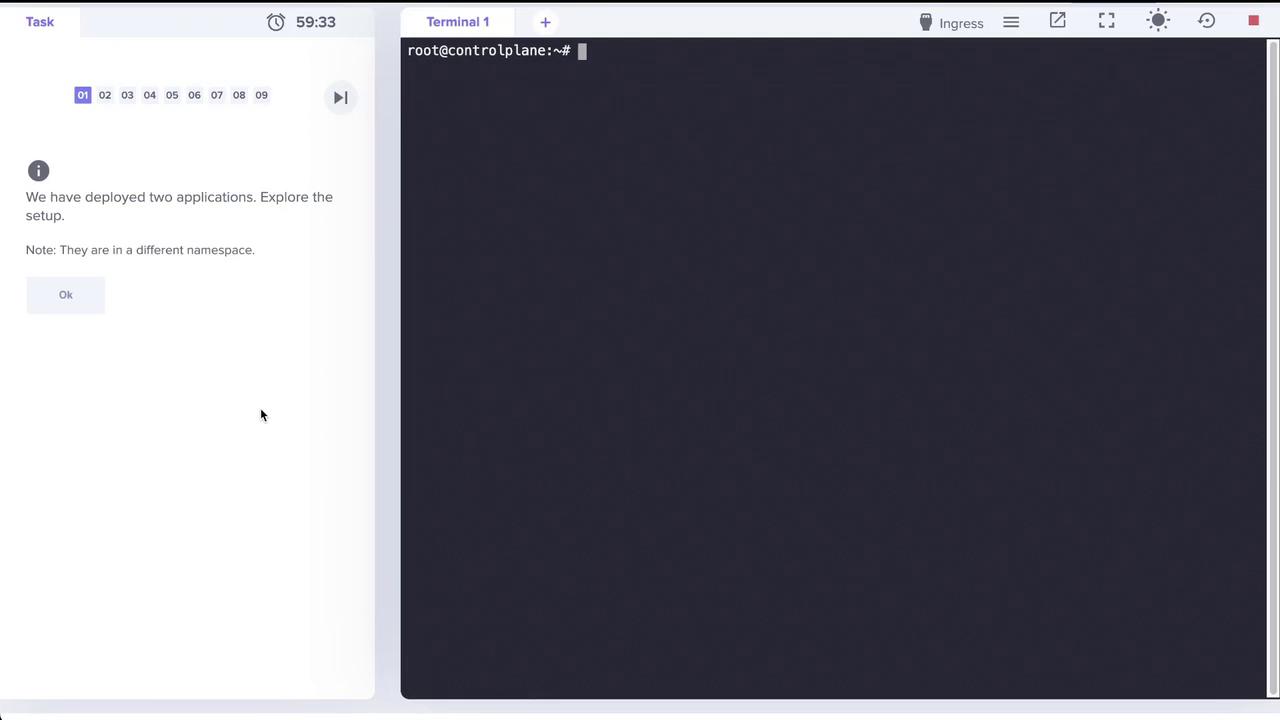Certified Kubernetes Application Developer - CKAD
Services Networking
Solution Ingress Networking 2
In this lesson, we explore Kubernetes Ingress Networking by deploying an Ingress Controller and configuring it to route traffic to two applications located in different namespaces. We will deploy a "video" app and a "wear" app within the app-space namespace while managing the Ingress Controller in its own namespace.

Step 1: Create the Ingress Namespace
Begin by creating a dedicated namespace for the Ingress Controller. Open your terminal and list all pods across all namespaces to confirm your setup:
root@controlplane:~# k get pod -A
NAMESPACE NAME READY STATUS RESTARTS AGE
app-space default-backend-5cf9fb9d-jqcp2 1/1 Running 0 50s
app-space webapp-video-84f8655bd8-qpb5n 1/1 Running 0 50s
app-space webapp-wear-6f19449555-mmtqh 1/1 Running 0 49s
kube-system coredns-74ff55c5b-4zg8j 1/1 Running 0 20m
kube-system coredns-74ff55c5b-gffzq 1/1 Running 0 20m
kube-system etcd-controlplane 1/1 Running 0 20m
kube-system kube-apiserver-controlplane 1/1 Running 0 20m
kube-system kube-controller-manager-controlplane 1/1 Running 0 20m
kube-system kube-flannel-ds-ks7d7 1/1 Running 0 20m
kube-system kube-proxy-4929b 1/1 Running 0 20m
kube-system kube-scheduler-controlplane 1/1 Running 0 20m
root@controlplane:~# k create namespace ingress-space
namespace/ingress-space created
root@controlplane:~#
Next, within the ingress-space namespace, create a ConfigMap (which may contain Nginx configuration data) and a Service Account. The related Roles and RoleBindings for the service account ingress-serviceaccount are pre-configured. Verify the roles and role bindings with:
root@controlplane:~# k get roles -n ingress-space
NAME CREATED AT
ingress-role 2022-04-19T21:05:42Z
root@controlplane:~# k get rolebindings -n ingress-space
NAME ROLE AGE
ingress-role-binding Role/ingress-role 20s
root@controlplane:~# k describe role ingress-role -n ingress-space
Name: ingress-role
Labels: app.kubernetes.io/name=ingress-nginx
app.kubernetes.io/part-of=ingress-nginx
Annotations: <none>
PolicyRule:
Resources Non-Resource URLs Resource Names Verbs
--------- ------------------ -------------- -----
configmaps [] []
configmaps [] [ingress-controller-leader-nginx]
endpoints [] []
namespaces [] []
pods [] []
secrets [] []
Step 2: Deploy the Ingress Controller
Deploy the Ingress Controller using the following manifest. This YAML configuration ensures that the controller runs within the ingress-space namespace and uses the pre-created service account. Note the proper indentation, namespace specification, and container arguments:
apiVersion: apps/v1
kind: Deployment
metadata:
name: ingress-controller
namespace: ingress-space
spec:
replicas: 1
selector:
matchLabels:
name: nginx-ingress
template:
metadata:
labels:
name: nginx-ingress
spec:
serviceAccountName: ingress-serviceaccount
containers:
- name: nginx-ingress-controller
image: quay.io/kubernetes-ingress-controller/nginx-ingress-controller:0.21.0
args:
- /nginx-ingress-controller
- --configmap=$(POD_NAMESPACE)/nginx-configuration
- --default-backend-service=app-space/default-http-backend
env:
- name: POD_NAME
valueFrom:
fieldRef:
fieldPath: metadata.name
- name: POD_NAMESPACE
valueFrom:
fieldRef:
fieldPath: metadata.namespace
ports:
- name: http
containerPort: 80
- name: https
containerPort: 443
Deploy the Ingress Controller by running:
root@controlplane:~# k create -f ingress-controller.yaml
deployment.apps/ingress-controller created
Monitor the pod status (optionally using --watch), and wait for the pod to transition from ContainerCreating to Running:
root@controlplane:~# k get pods -n ingress-space
NAME READY STATUS RESTARTS AGE
ingress-controller-5857685bf-qd8jz 0/1 ContainerCreating 0 10s
Note
After a short wait, the status should update to Running. This confirms that the Ingress Controller has been successfully deployed.
Step 3: Expose the Ingress Controller
To allow external access to your Ingress Controller, expose it using a Service of type NodePort. Execute the following command to expose the deployment:
root@controlplane:~# k expose deploy ingress-controller -n ingress-space --name ingress --port=80 --target-port=80 --type NodePort
service/ingress exposed
Verify the details of the newly created service:
root@controlplane:~# k get svc -n ingress-space
NAME TYPE CLUSTER-IP EXTERNAL-IP PORT(S) AGE
ingress NodePort 10.109.33.190 <none> 80:32741/TCP 9s
If you prefer a specific NodePort (for example, port 30080), edit the service accordingly:
root@controlplane:~# k edit svc ingress -n ingress-space
Change the nodePort value to 30080 and save the changes.
Step 4: Create the Ingress Resource
Now, create an Ingress resource to route traffic to the applications deployed in the app-space namespace. The Ingress rules will direct:
- Requests to
/wearto thewear-serviceon port 8080. - Requests to
/watchto thevideo-serviceon port 8080.
Run the following command to create the Ingress:
root@controlplane:~# k create ingress ingress-wear-watch -n app-space --rule="/wear=wear-service:8080" --rule="/watch=video-service:8080"
ingress.networking.k8s.io/ingress-wear-watch created
Verify the Ingress resource with:
root@controlplane:~# k get ingress -n app-space
NAME CLASS HOSTS ADDRESS PORTS AGE
ingress-wear-watch <none> * <none> 80 8s
Step 5: Debugging and Resolving Redirect Issues
If you observe that requests to the /watch path are not reaching the intended video service, and the logs remain inactive, review the Ingress Controller logs. You might see repeated HTTP 308 redirects indicating SSL redirection is enforced:
121.6.144.181 - - [19/Apr/2022:21:15:38 +0000] "GET /watch HTTP/1.1" 308 171 "-" "Mozilla/5.0 ..." ... [app-space-video-service-8080] ...
To resolve this, disable SSL redirection for this Ingress resource by adding the appropriate annotations. Edit the Ingress manifest to include:
apiVersion: networking.k8s.io/v1
kind: Ingress
metadata:
name: ingress-wear-watch
namespace: app-space
annotations:
nginx.ingress.kubernetes.io/rewrite-target: /
nginx.ingress.kubernetes.io/ssl-redirect: "false"
spec:
rules:
- http:
paths:
- path: /wear
pathType: Exact
backend:
service:
name: wear-service
port:
number: 8080
- path: /watch
pathType: Exact
backend:
service:
name: video-service
port:
number: 8080
status:
loadBalancer:
ingress: []
Apply the changes by editing the existing Ingress:
root@controlplane:~# k edit ingress ingress-wear-watch -n app-space
Note
After saving these changes, the SSL redirect issue should be resolved, ensuring proper routing of traffic to both applications.
Final Verification
Perform a final check of the service and Ingress statuses to confirm that everything is functioning as expected:
root@controlplane:~# k get svc -n app-space
NAME TYPE CLUSTER-IP EXTERNAL-IP PORT(S) AGE
default-http-backend ClusterIP 10.109.67.66 <none> 80/TCP 10m
video-service ClusterIP 10.99.96.249 <none> 8080/TCP 10m
wear-service ClusterIP 10.105.104.69 <none> 8080/TCP 10m
root@controlplane:~# k get ingress -n app-space
NAME CLASS HOSTS ADDRESS PORTS AGE
ingress-wear-watch <none> * 80 3m24s
This confirms that the Ingress Controller is properly deployed, exposed, and routing traffic correctly with SSL redirection disabled.
That concludes the lab on Kubernetes Ingress Networking. For further reading on Ingress configurations and best practices, consider exploring the following resources:
- Kubernetes Ingress Documentation
- NGINX Ingress Controller GitHub Repository
- Kubernetes Networking Concepts
Watch Video
Watch video content